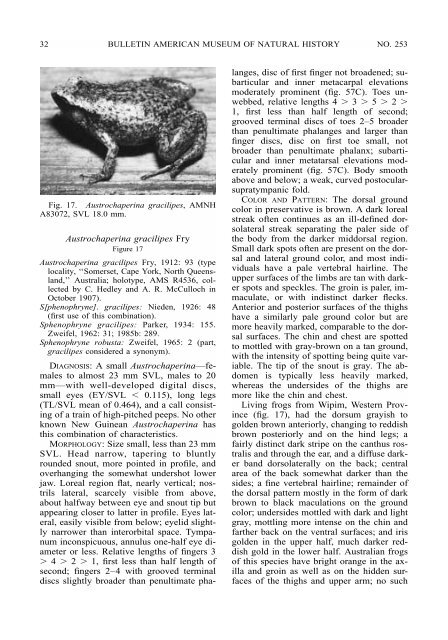SPHENOPHRYNE - American Museum of Natural History
SPHENOPHRYNE - American Museum of Natural History
SPHENOPHRYNE - American Museum of Natural History
You also want an ePaper? Increase the reach of your titles
YUMPU automatically turns print PDFs into web optimized ePapers that Google loves.
32 BULLETIN AMERICAN MUSEUM OF NATURAL HISTORY NO. 253<br />
Fig. 17. Austrochaperina gracilipes, AMNH<br />
A83072, SVL 18.0 mm.<br />
Austrochaperina gracilipes Fry<br />
Figure 17<br />
Austrochaperina gracilipes Fry, 1912: 93 (type<br />
locality, ‘‘Somerset, Cape York, North Queensland,’’<br />
Australia; holotype, AMS R4536, collected<br />
by C. Hedley and A. R. McCulloch in<br />
October 1907).<br />
S[phenophryne]. gracilipes: Nieden, 1926: 48<br />
(first use <strong>of</strong> this combination).<br />
Sphenophryne gracilipes: Parker, 1934: 155.<br />
Zweifel, 1962: 31; 1985b: 289.<br />
Sphenophryne robusta: Zweifel, 1965: 2 (part,<br />
gracilipes considered a synonym).<br />
DIAGNOSIS: A small Austrochaperina—females<br />
to almost 23 mm SVL, males to 20<br />
mm—with well-developed digital discs,<br />
small eyes (EY/SVL 0.115), long legs<br />
(TL/SVL mean <strong>of</strong> 0.464), and a call consisting<br />
<strong>of</strong> a train <strong>of</strong> high-pitched peeps. No other<br />
known New Guinean Austrochaperina has<br />
this combination <strong>of</strong> characteristics.<br />
MORPHOLOGY: Size small, less than 23 mm<br />
SVL. Head narrow, tapering to bluntly<br />
rounded snout, more pointed in pr<strong>of</strong>ile, and<br />
overhanging the somewhat undershot lower<br />
jaw. Loreal region flat, nearly vertical; nostrils<br />
lateral, scarcely visible from above,<br />
about halfway between eye and snout tip but<br />
appearing closer to latter in pr<strong>of</strong>ile. Eyes lateral,<br />
easily visible from below; eyelid slightly<br />
narrower than interorbital space. Tympanum<br />
inconspicuous, annulus one-half eye diameter<br />
or less. Relative lengths <strong>of</strong> fingers 3<br />
4 2 1, first less than half length <strong>of</strong><br />
second; fingers 2–4 with grooved terminal<br />
discs slightly broader than penultimate pha-<br />
langes, disc <strong>of</strong> first finger not broadened; subarticular<br />
and inner metacarpal elevations<br />
moderately prominent (fig. 57C). Toes unwebbed,<br />
relative lengths 4 3 5 2 <br />
1, first less than half length <strong>of</strong> second;<br />
grooved terminal discs <strong>of</strong> toes 2–5 broader<br />
than penultimate phalanges and larger than<br />
finger discs, disc on first toe small, not<br />
broader than penultimate phalanx; subarticular<br />
and inner metatarsal elevations moderately<br />
prominent (fig. 57C). Body smooth<br />
above and below; a weak, curved postocularsupratympanic<br />
fold.<br />
COLOR AND PATTERN: The dorsal ground<br />
color in preservative is brown. A dark loreal<br />
streak <strong>of</strong>ten continues as an ill-defined dorsolateral<br />
streak separating the paler side <strong>of</strong><br />
the body from the darker middorsal region.<br />
Small dark spots <strong>of</strong>ten are present on the dorsal<br />
and lateral ground color, and most individuals<br />
have a pale vertebral hairline. The<br />
upper surfaces <strong>of</strong> the limbs are tan with darker<br />
spots and speckles. The groin is paler, immaculate,<br />
or with indistinct darker flecks.<br />
Anterior and posterior surfaces <strong>of</strong> the thighs<br />
have a similarly pale ground color but are<br />
more heavily marked, comparable to the dorsal<br />
surfaces. The chin and chest are spotted<br />
to mottled with gray-brown on a tan ground,<br />
with the intensity <strong>of</strong> spotting being quite variable.<br />
The tip <strong>of</strong> the snout is gray. The abdomen<br />
is typically less heavily marked,<br />
whereas the undersides <strong>of</strong> the thighs are<br />
more like the chin and chest.<br />
Living frogs from Wipim, Western Province<br />
(fig. 17), had the dorsum grayish to<br />
golden brown anteriorly, changing to reddish<br />
brown posteriorly and on the hind legs; a<br />
fairly distinct dark stripe on the canthus rostralis<br />
and through the ear, and a diffuse darker<br />
band dorsolaterally on the back; central<br />
area <strong>of</strong> the back somewhat darker than the<br />
sides; a fine vertebral hairline; remainder <strong>of</strong><br />
the dorsal pattern mostly in the form <strong>of</strong> dark<br />
brown to black maculations on the ground<br />
color; undersides mottled with dark and light<br />
gray, mottling more intense on the chin and<br />
farther back on the ventral surfaces; and iris<br />
golden in the upper half, much darker reddish<br />
gold in the lower half. Australian frogs<br />
<strong>of</strong> this species have bright orange in the axilla<br />
and groin as well as on the hidden surfaces<br />
<strong>of</strong> the thighs and upper arm; no such
















